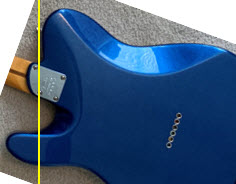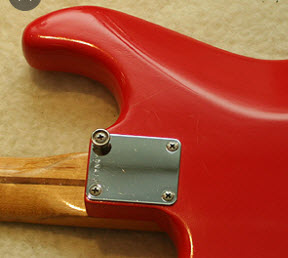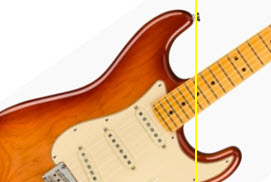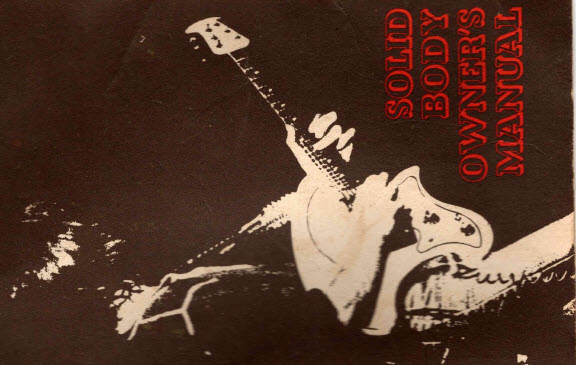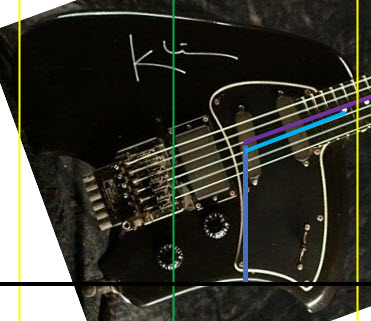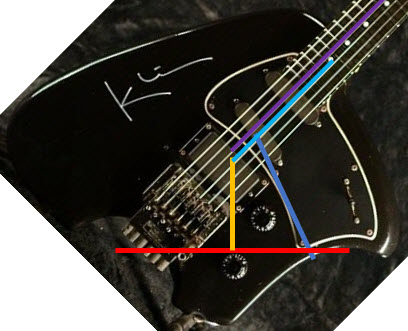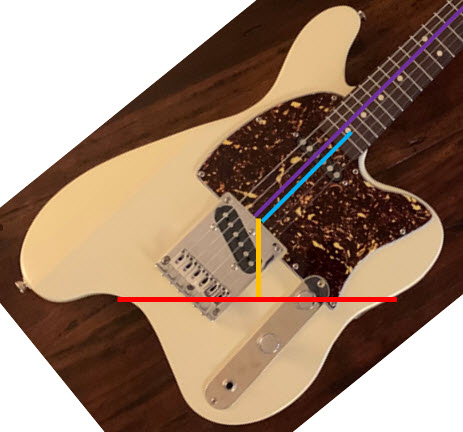|
|
|
|
|
Electric Guitar Ergonomic Analysis
|
|
|
There are dozens of factors
that affect the ergonomics of a guitar. The analysis below
focuses primarily on the shape, and to some extent the weight and balance, of the
ergonomic electric guitar body.
This discussion focuses on the ergonomics of electric guitars because there are
many less sonic constraints on the electric guitar body
relative to an acoustic guitar body.
Changes to the shape of an acoustic guitar body will almost
always have a dramatic effect on the way the guitar sounds. Changes
to the shape of an electric guitar body have a much smaller
effect on the tone, though many will say that changes to the
weight and density of the guitar body will have a larger sonic
effect. Of course the weight of the guitar is an important
ergonomic consideration, primarily when playing while
standing. I want to point out that the shape, weight and balance of the
guitar neck are
equally important to the ergonomics of the electric guitar, and some
might say even more important, than those of the
guitar body. I discuss the weight and balance of the neck below a bit, but
the ergonomics of the shape of the guitar neck are a study unto
themselves and I do not discuss them here,
To me, the ergonomics of electric guitars is really a discussion
of degree and differences. By this I mean, "how does this "ergonomic"
electric guitar
differ from a traditional, "non-ergonomic" guitar?"
Conducting this analysis requires a reference standard and for this I am choosing the
venerable Telecaster as the reference electric guitar for ergonomic
analysis. I chose the Telecaster as the standard
because it was among the very first electric guitars (released to
the public in 1951) and it has a basic, "no frills" design
that provides a crisp departure point for comparing and contrasting
of its ergonomics to other electric guitar designs. Perhaps
the best, reason to choose the
Telecaster as a reference for comparision while examining the
ergonomics of other guitars is that it was followed three
years later with the Stratocaster in 1954 and then four years after
that with the Jazzmaster in 1958. Both the Stratocaster and the
Jazzmaster had very specific changes meant to improve the ergonomics
of the guitar that preceded it. Examining these changes provides a
basis for understanding electric guitar ergonomics. After
discussing the Telecaster -> Stratocaster -> Jazzmaster
lineage, this page lists and discusses a number of other ergonomic
electric guitars. These are presented in generally
chronological order. This is not intended to be an exhaustive
list of ergonomic guitar designs. That would be a very long
list! Rather, these electric guitars were chosen because they exhibited
specific ergonomic guitar features I wanted to point out and discuss.
Generally speaking, I'm not ranking these (or any guitars) in
any way. My aim is to point out specific ergonomic features and try to explain the benefits and drawbacks of each. Finally,
you may be wondering why a PhD robotics guy like me is writing
about electric guitar ergonomic analysis. First of all, I'm a guitar
player and very interested in not getting repetitive stress
injuries. Therefore, I have done quite a bit of research on
electric guitar
ergonomics. Secondly, my doctoral dissertation focused on
geometry and kinematics, though in the context of robotics. In the analysis and
discussion below, I am simply applying the principles of
geometry and kinematics to the ergonomics of electric guitars. In
all the discussion below I try to stick to the facts and let
the data speak for themselves. In some places I also provide
commentary that reflects my opinions regarding electric guitar
ergonomics. Please keep in mind that
where there is commentary rather than data, these comments
reflect my opinions and not necessarily those of any other
person or company. |
|
|
|
Telecaster Electric Guitar
|
Telecaster Electric Guitar Ergonomics while playing
seated
|
|
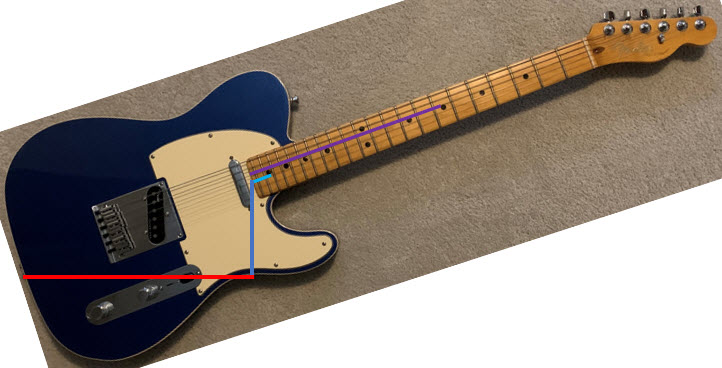
|
|
| |
1950 saw the introduction of the Esquire electric
guitar. It went through two name changes until it eventually
was called the Telecaster electric guitar in 1951. The Esquire only had the
bridge pickup and the Telecaster also has one in the neck,
but the number of pickups to me is not an ergonomic
consideration for an electric guitar.
To begin with, I'm going to present some
objective analysis of the ergonomics of the Telecaster being
played in the sitting position with the guitar resting on the
leg(s). There are two
different sitting positions guitar players primarily use. The first, and by far
most common, is the folk (also called traditional)
sitting position with the guitar resting on the right leg (for
right-handed players). The other is the classical sitting
position with the guitar resting on the left leg (or both
legs). Almost all
guitars are designed to be played in the folk sitting
position. Strictly speaking any guitar could be played in
either position, but as a practical matter, any particular
guitar is almost always going to be more ergonomic in one position or the
other. The reasons for this are discussed more below. Also in
the discussion below, I'm sure that I will use the words "left" and
"right" to discuss various statistics related to
electric guitar ergonomics. Unless stated
otherwise, these will always be for playing the guitar
right-handed. Just swap "left" with
"right" to adapt the discussion to left-handed
players.
A number of these statistics are affected
by the scale length of the guitar, though the effect is
very small. All "adult sized" guitars that I know of
have a scale length of 25.5 inches to 24.75 inches . To me, the effects of scale length within this range
are negligible relative to the overall magnitude of the
measurements I will be making. Generally speaking with regards to ergonomics,
the shorter scale length makes the first few frets a bit
easier to reach and multi-fret stretches a little easer to
make. The downside is that it's a little more crowded between
frets if you need to fit more than two fingers between two
adjacent frets. For these three reasons, "student"
sized guitars typically have a scale length shortened by two
inches or so. The scale length also affects the tone of the
guitar, but as they say, "that's another story."
Tilt range - 0 to 20 degrees - In the figure above the
blue T-style guitar is tilted above vertical by about 20 degrees. 45 degrees is
often cited as the "most" ergonomic tilt for a guitar, but this is for a player
sitting in the classical guitar
position. For reasons that will be explained in the
context of the Jazzmaster ergonomic electric guitar, 45 degrees
may be too much if you are playing the guitar on your right
leg. Regardless of exactly how much tilt is optimal for an
ergonomic electric guitar, I'm sure most, if not all, experts will tell you that the
"best" tilt with respect to ergonomics is somewhere between 0 and 45 degrees.
Regardless of what is best, we can see the maximum tilt the
Telecaster will comfortably support while sitting is about 20 degrees. At
this angle the bottom of the lower horn is parallel with the
horizontal. If the guitar tilts any more than this, it will
tend to slip off the player's leg. For the analysis below, all of the
ergonomic statistics were determined with the guitars at the maximum
tilt angle unless specifically stated otherwise.
Rest point - 0.9 inches behind 21st
fret - The rest
point is determined by projecting a line straight up from
where the guitar is resting on the leg and then ending the
line midway up the fret board (between the 3rd and 4th
strings). This is shown by the
darker blue
line in the figure above and we can see that this line ends
about an inch behind the 21st fret. The light blue line shows
this measurement. The rest point is very much related to the
offset in offset ergonomic electric guitars. Offset is often
described as the asymmetry of the upper half of the
guitar body relative to the lower half of the guitar and it
usually means the lower half of the guitar body is moved away
from the neck. This is discussed further below with regards to the
Jazzmaster ergonomic electric guitar. Where the guitar sits on
the leg relative to a fixed point on the fretboard (the rest point) is one way
to measure the magnitude of the offset of an offset ergonomic
electric guitar.
Rest point rise - 5 inches - This is the height
of the middle of the fretboard directly above where the guitar is
resting.
In the figure above it is indicated by the length of the vertical
blue line. This line ends between the 3rd and 4th strings and measures 5
inches in length. The rest point rise is effectively an
ergonomic measure of how high the player's strumming hand will be above
their lap when they are playing.
:Left hand reach - 10.6 inches - The
purple line in the figure above indicates this measurement of
electric guitar ergonomics. The length of the purple line from
above the rest point to the 7th fret is
about 10.6 inches. This gives a measure of the ability of your
left hand to reach the top and the bottom of the neck. As with
most ergonomic factors, this one too is a tradeoff. A
shorter left hand reach may make it easier to reach the first
few frets, but it may also make it harder to reach the last
few frets because your body will be getting in the way of your
left arm. Note that this isn't really an independent
ergonomic factor. It can be
calculated from the light blue line
and the scale length of the guitar. Nevertheless, I broke it
out separately to help visualize the measurement.
Leg spread - 12 inches -This is an
ergonomic measure of how suitable the guitar is for playing in the
classical seated position with the guitar resting on both the
left and right legs. This measures how far apart the player
will need to spread their legs to allow the guitar to rest on
both of them. For right handed players, a greater leg spread
means the player will need to angle his right leg farther to
the right. Find a picture of anyone playing a standard
electric guitar in the classical seated position and it will
be obvious what I mean by "angling the right leg to the right."
It's not very ergonomic or comfortable, but it's one of the
ergonomic tradeoffs if a player wants to play in the classical
seated position with a "traditionally" shaped
guitar.
I do have one final comment regarding these
sitting ergonomic measures. If a player wants to place the
guitar so that it is positioned relative to their body when
they are sitting the same as it is positioned when they are
standing (a worthy goal in my opinion, and for more than only
ergonomic reasons) one option is simply to
support the guitar with a strap while you are sitting.
The downside of this is that now the weight of the guitar will
be supported by the musculoskeletal structure of your hips,
back, and shoulder, etc. rather than just traveling through
your leg bones to the ground. Furthermore, typical guitar
straps are terrible ergonomically. I discuss this more below.
|
|
|
|
Telecaster Electric Guitar Ergonomics while playing
standing
|
|
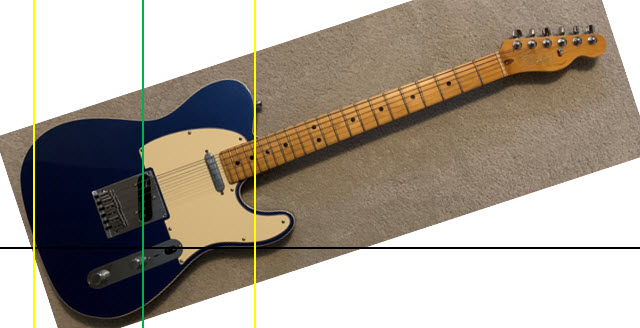
|
|
|
|
This analysis of the ergonomic aspects of
playing the electric guitar while standing focuses on the
weight of the guitar and the location of the strap buttons
relative to the rest of the guitar. Obviously the distribution
of the weight impacts the ergonomics of the guitar, most
importantly in terms of balance, but even different guitars of
the same type balance differently depending on the woods used
in their bodies, the kind of tuners they have, etc. In terms of balance, the main ergonomic
challenge with electric guitars is usually "neck dive." Next dive is the tendency
of the guitar to rotate around the player's shoulders such the
the headstock of the guitar gets closer to the ground. The
shape of the guitar's body is another ergonomic consideration
and is briefly discussed in the comparisons between T-style
and other guitars.
Determining a "optimal" balance
for the electric guitar while it is supported by the strap is
a complicated ergonomic exercise. It would be easy to say, "the
weight at both strap buttons should be the same," but
that's not correct. The end of the strap connected to the
front button is pulling almost straight up. The end of the
strap connected to the back button is pulling up, but it is
also pulling backwards towards the player. If the weight at
both strap buttons were the same, then the tension in the
strap at the back of the guitar would have to be greater than
that at the front because it supporting both the upward and backward loads.
If there was no friction between a player's
shoulders and the inside of the guitar strap, then the guitar
would rotate to its balanced tilt angle whenever the player's
hands were off the guitar. Of course there is always friction
between a player's shoulders and the inside of the strap so
the guitar can't rotate freely. Furthermore, many players wear
wide guitar straps with unfinished leather or other "high-friction"
material on the inside
of the strap. This mitigates to some extent the ergonomic
issues with a guitar that is "neck heavy" because
the friction prevents the neck of the guitar from actually diving towards
the ground. Because of the effects of friction, smaller
imbalances in weight between the front and back strap buttons may be barely perceptible to the player. As the
imbalance grows larger, the muscles in the player's neck, back and
shoulders need to counteract the friction forces to an
increasingly greater detriment to ergonomics.
Strap button midpoint - bridge
pickup - As shown with the green vertical line in the figure
above, the midpoint between the two strap buttons is at the
bridge pickup with the T-style guitars. With regards to
ergonomics, this statistic generally relates to
how the guitar strap will hang over the player's body. If the
midpoint moves towards the player's right, the headstock will
mover farther away to the player's left, though as discussed
below, the strap
button forward location has more of an effect on this
tendency.
Strap button forward location - 19th
fret - The right most vertical yellow line in the figure above
shows that the strap button forward location on a Telecaster
is at the 19th fret when the guitar is tilted at 20 degrees.
The Telecaster is known to be a bit neck- heavy, but not to
the point of being an issue. Though with all else being equal, the
Telecaster would be less neck- heavy, and thus be a more
ergonomic electric guitar, if the strap button
location could magically be moved toward the headstock an inch or
two.
The issue of neck dive is a perfect example
of the perils associated with ergonomic analysis of guitars.
Even with its reputation for having unfortunate neck-dive ergonomics, the venerable Gibson
SG electric guitar is one of the most popular guitars
there is. It's easy to understand why the SG has poor neck- dive ergonomics. The
forward strap button location on the SG
is at the front of the neck plate, (approximately like it is with a
T-style guitar at 20 degrees tilt) but the weight of an SG body is
much less than the weight of the T-style body. The
weight of the body relative to the neck shifts the balance of the SG
toward the headstock and makes it neck-heavy.
The strap button forward location also very
much affects how far the left hand will need to reach to get
to the first few frets. This is because the strap tends to
hang straight down from the player's shoulder to the front strap button. Thus, if the
forward strap button is moved towards the neck, then the
headstock of the guitar will get closer to the player.
Conversely, if the forward strap button moves towards the
bridge, then the headstock of the guitar will get farther from
the player.
Speaking of guitar
straps, the almost universal style of hanging the weight of
the guitar over
one shoulder is not good ergonomically. It seems to me the weight of the
guitar should be carried about equally on both shoulders. There are
ergonomic straps available that hang over both
shoulders, and another style that hangs around the waist.
There's even a strap that hangs over both shoulders and let's
you spin the guitar ZZ Top style!
Total weight - 7.5 lbs - Obviously
the total weight of the guitar affects the ergonomics when
playing the instrument while standing. With all else being
equal, a lighter guitar will be easier to support on a strap
than a heavier guitar. With regards to total weight, the
Gibson SG is a good example of in electric guitar ergonomic
analysis. The SG is
a very light guitar, which is good ergonomically because it's less total
weight for your musculoskeletal structure to support, but the
trade-off is a tendency towards neck dive.
By the way, the 7.5 lbs is what my
Telecaster weighs. Depending on the type of wood the body is
made from, a Telecaster will weigh anywhere from 7 to 8.5 lbs.
This leads to another example of a tradeoff in electric guitar
ergonomic analysis, but in
this case the tradeoff is with the tone of the
guitar. Many people think guitars with bodies made of heavier
woods sound
better than those made with lighter woods. Other players think any difference
in sound quality between heavy and lighter woods is either
imperceptible or extremely small and they would prefer the
lighter guitar because it is easier to support on a strap. As
discussed, the tradeoff in ergonomics is that guitars with lighter
bodies can easily become imbalanced and heavy towards the neck.
|
|
|
|
Stratocaster Ergonomic Electric Guitar
|
|
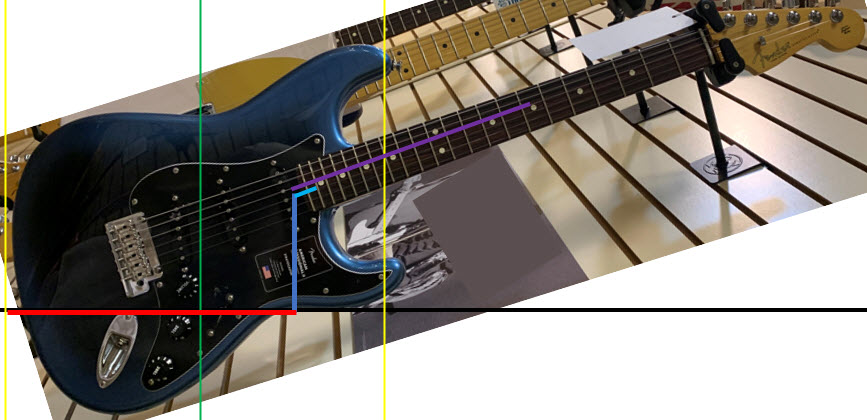
|
|
|
| |
1954 saw the introduction of the Stratocaster
electric guitar. It was the next guitar in the Esquire ->
Telecaster lineage. To start with, here is the same list of
ergonomic statistics for the Stratocaster that was defined
above for the Telecaster guitar.
|
Seated tilt range -
0 to 20 degrees
Rest point - 0.9 inches behind 21st fret
Rest point rise
- 5 inches
Left hand reach - 10.6 inches |
Leg spread - 12 inches
Strap
button midpoint - Between the bridge and middle pickups
Strap
button forward location - 15th fret
Total weight -
7.5 pounds |
Based on these statistics, the ergonomics
of both guitars being played in the sitting position are about
the same. I've played both guitars in the folk sitting position and
they seem about the same ergonomically to me, at least with
regards to the position of the guitar on my leg. That being
said, the Stratocaster has a number of design changes that
most people agree improve its ergonomics.
1. Arm carve - The Telecaster has almost 90 degree edges all around the
front and back of the guitar body. Ergonomics 101 will tell
you that sharp edges and corners are not desirable in an
ergonomic electric guitar. The Stratocaster rounded all these
edges, but added even more carving where the inside of the
strumming forearm contacts the
guitar body. This is one of the most obvious ergonomic
improvements there is to be made over the design of the Telecaster. It's
also an easy (though irreversible) ergonomic change to make to a T-style
guitar and many players, from the famous to the not so
famous simply add an arm carve to a standard Telecaster using a sander. Other than a
desire to keep the look of the Telecaster exactly like the
original, there really is no tradeoff to this ergonomic change
and most electric guitars produced today have an arm carve. The main
exception would be the Les Paul style guitars, but these have
a rounded top that ergonomically gets most of the way there.
2. Belly carve - This
ergonomic feature is on the back of the guitar so you can't see it in
the image of the Stratocaster above, but you can see it on the
back of the blue "modern" Telecaster and the red
Stratocaster below. This feature is almost always called a
belly carve, but that's not an accurate name. There is no way to
position the guitar while seated or standing to get your
belly near that
carve. When standing, the carve makes room for the lower part
of the rib cage, which I assume is why the carve is there
since the ergonomic aim of the Stratocaster was to be more
comfortable to play while standing than its predecessor the
Stratocaster. That being said, it also is an ergonomic carve that makes
some room for a
player's breast when they are leaning forward over the guitar in
the traditional seated position. Leaning over a guitar is
most certainly not preferable in a guitar ergonomics sense, but a lot
of players do it and the
carve makes it more comfortable for them. As with the arm
carve, most modern guitars have a breast carve.
3. Extended
top horn - The extended top horn was added to improve the
ergonomic balance of the guitar when the player is in the standing
position. As you can see in the image above, at a 20 degree
tilt the front strap button extends down to the 17th fret on
the Stratocaster versus the 19th fret for the Telecaster. This
moves the strap attachment forward about 1 inch, which makes
the guitar less neck heavy. As with most things regarding
electric guitar ergonomics, there's more to this analysis than
simply extending the top horn. This is because the tilt of the
guitar is part of the equation.
|
|
|
|
Ergonomic Considerations Regarding the Front Strap
Button Location
|
|
|
|
|
| |
The image on the left shows a back view of
a modern Telecaster tilted at 20 degrees. As you can see, the front
of the neck plate is actually forward of the front strap
button by a bit. This suggests that at tilt angles greater
than about 19 degrees a
Telecaster will actually balance better ergonimically if the forward strap
button is attached at the neck plate. I actually own this blue
Telecaster and I've tried locating the front strap button on
the neck plate and agreed the guitar felt a little
ergonomically balanced this way, but I play at a tilt angle of about 45
degrees. I also preferred the way the front of the strap lay
flat against my body rather than twisting away from the front
strap button to go over my shoulder the way it does in the
standard button location. Finally, it seemed to me that the
strap was more reliably held by the button when the strap
didn't have to twist 90 degrees to go over my shoulder.
The middle image of the red Stratocaster
above shows a replica of the guitar played by a young Mark
Knopfler. There are lots of guitars that mount the front strap
button in this location. One ergonomic benefit I see of this location is
that the balance and position of the guitar will stay pretty constant for
tilt angles between 0 and 45 degrees. That's not the case if
the strap is mounted to the top horn. With the strap mounted
in this location, the body of the guitar will move towards the
player's fretting hand and the distribution of weight will move
towards the headstock (meaning the guitar will get
progressively more neck-heavy) as the tilt angle rotates from
0 to 45 degrees. This happens because the top
horn is above the centerline of the fret board, and the more
above the fret board it is, the more pronounced the effects.
This may not matter to you if you always play with the guitar
at the same tilt angle, but if you do change the tilt of the
guitar while you are playing (perhaps switching between using
a flat pick and playing finger style), it's something you
might consider as part of the guitar's ergonomics.
As discussed above, at 20 degree tilt, the
Stratocaster top horn moves the front strap attachment point
towards the neck of the guitar by about an inch relative to
the Telecaster. Simple geometry shows that at 0 degrees tilt
the front strap button would be about 2.5 inches towards the
neck of the guitar relative to the Telecaster. (1/cos(20) =
2.45). The image above at the right shows a Stratocaster tilted at
35 degrees. As can be seen in this image, the Stratocaster would
balance about the same at 35 degrees whether it was attached
at the front of the top horn or at the front of the neck
plate. Between tilt angles of 35 to 45 degrees, the
guitar should balance better ergonomically if attached at the top
plate.
Here's one last observation about affixing
the front strap button at the neck plate of the guitar. It
makes the top horn of the guitar PRETTY MUCH useless in terms of
ergonomics! In fact, removing the top horn makes the
ergonomics better in the sense that it gets the top horn out of
the way of the player's body and reduces the over all weight
of the guitar. As discussed, decreasing the weight of the
guitar body does tend to make the guitar more neck-heavy,
but because the top horn is right at the strap attachment
point, its weight does not have enough leverage to make much
ergonomic difference in the balance.
This leads to a general rule about weight
and balance. The farther from the center point of the guitar
the weight is, the more of an effect it will have on the
balance. This means that weight in
the headstock will have the most impact on the balance of the
guitar relative to weight in any other part of the guitar. As
a rule of thumb in electric guitar ergonomic analysis, weight at the center of the headstock will
have a little more than twice (2.2 times on a T-style guitar) the effect on
balance than weight at the center of the body.
This also leads to another tradeoff in the ergonomic design of the
guitar. For better balance, it would be typically be great to remove
weight from the headstock, or remove the head stock entirely.
The sonic consideration though is that that mass at the headstock
affects the tone of the guitar, and unless something is also
done to simultaneously make the neck stiffer, the sonic changes of removing
mass at the headstock may not be for the better. In fact, you can buy brass
headstock plates that in some cases will noticeably improve
the tone of an electric guitar, though these are not as
popular as they once were, and ergonomically they come at the
expense of making the guitar more neck heavy..
And ergonomics aside, I don't like the idea of the
of the guitar hanging from one of the four screws holding the
neck to the body. The neck joint is extremely important both
mechanically and sonically. It would be much better if
another hole was drilled in the neck plate and a shorter screw
was used that went through the button, through the neck plate,
and then into the body of the guitar (but not all the way into
the neck).
|
|
|
|
Jazzmaster Ergonomic Electric Guitar
|
|
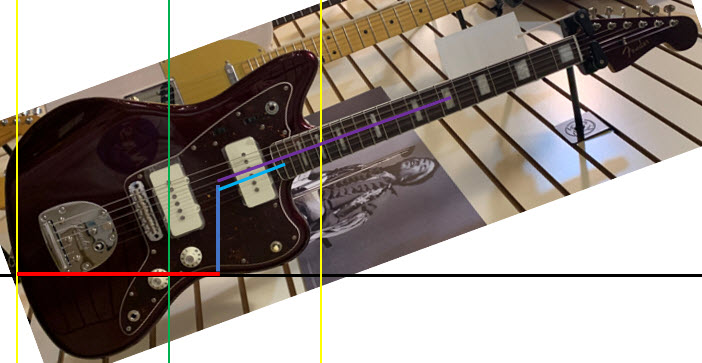
|
|
|
| |
1958 saw the introduction of the Jazzmaster
ergonomic electric guitar. It was the next
electric guitar released in the Esquire -> Telecaster ->
Stratocaster lineage. This guitar was designed to be more ergonomic to play
seated than either the Telecaster or the Stratocaster. The
statistics below reflect this design goal.
|
Seated tilt range - 0 to 20 degrees
Rest point -
3.8 inches behind the 21st fret
Rest point rise -
4.7 inches
Left hand reach - 13.4 inches |
Leg spread -
9.5 inches
Strap button midpoint - Bridge pickup
Strap
button forward location - 17th fret
Total weight - 8.5
pounds |
These statistics show several ergonomic
changes made to the Jazzmaster relative to the Stratocaster.
The most striking is that the rest point has been moved
towards the rear of the guitar (away from the headstock) by
almost three inches. That's what makes the Jazzmaster an
"offset" guitar. The bottom half of the guitar is
offset (away) from the headstock relative to the top of the
guitar. This in turn shifts the rest of the guitar towards the
player's belly button (their centerline) substantially when it is being played sitting down in the folk style.
Centering the guitar better makes it easier to play and makes
it sit on the leg in a position that ergonomically more closely resembles
how the guitar hangs from the strap. Both of these are good
things. It also moves the headstock farther away from the
player's centerline the same amount, which to me feels
more comfortable. These are all ergonomic positives. Why not offset the
guitar six inches? That would put the guitar about evenly
spaced between the player's two legs. That must be better,
right?
Once again, there are ergonomic trade offs associated
with offsetting the guitar. The biggest one to me is that it
makes the guitar more neck heavy when being played sitting
down. This is at least one of the reasons why the Jazzmaster is
heavier than the Stratocaster. The heavier weight of the body
makes the offset guitar balance better on the leg. Also, you
can tell by looking that this weight is distributed at the
very back (away from the headstock) of the guitar where it
will have the most leverage to counteract the weight that was
moved forward of the rest point by offsetting the
guitar.
Strap button forward location - The strap
button forward location moved away from the headstock two
frets, or about an inch, relative to the Stratocaster. With
the added weight at the rear of the Jazzmaster, there was no
ergonomic need to move the front strap button as far forward to balance
the guitar.
Left hand reach - This ergonomic statistic grew
because the offset shifted the guitar toward the player's
left. To me, it's more comfortable to play with this shift
because it moves the higher frets away from my body and the
lower frets are still easy to get to..
Rest point rise - This statistic got a
little bit (0.3 inches) smaller. The rest point rise decreasing is an
ergonomic side effect of offsetting a guitar.
The more the guitar is tilted, the more
the rest point rise will decrease with offset. Because the
guitar is tilted by 20 degrees when these measurements are
taken, the rest point rise should have decreased by about 1
inch (2.8*sin(20 degrees) = 0.96)). There is material added to the bottom of the
Jazzmaster body of the guitar to bring the
rest point back up to about where it is on a Tele or Strat.
Leg spread - The leg spread decreased to
9.5 inches, which potentially would indicate this guitar might be easier
to play in the classical sitting position than either a
Stratocaster or Telecaster. The challenge is that an offset
that will help the ergonomics of guitar being played in the
folk position, will likely hurt the ergonomics of a guitar
that's being played in the classical position. In other words,
with regards to ergonomics, the offset for a guitar resting on the left leg should
generally be in the opposite direction of a guitar resting on
the right leg.
|
|
|
|
Ovation Breadwinner Ergonomic Guitar
|
|
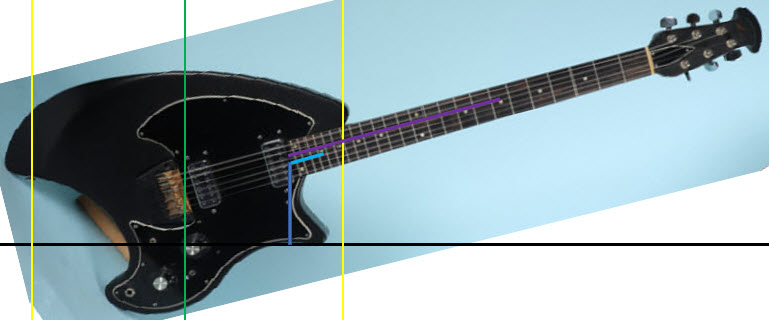
|
|
|
|
|
|
|
| |
The Ovation Breadwinner ergonomic guitar was produced from 1972 to
1979. The first thing you notice about these guitars is the
striking shape of the body. Even though they have nothing to
do with ergonomics,
these guitars were also among the first (if not the first) guitars to come with
active electronics, because there is an FET preamp on board.
As seen above, there are two body shapes for this guitar. The
upper image shows a black, standard Breadwinner and the lower
image shows a brown Breadwinner limited on the left. Aesthetically,
it is easy to notice the
Breadwinner Limited has a cutout to the upper surface of the body
that is reminiscent of a traditional acoustic guitar shape.
Personally, I prefer the looks of the Limited shape. In addition to
this aesthetic difference, there are also some differences in
ergonomic statistics, primarily with regards to how high the
guitars sit on the player's legs. The ergonomic statistics for both
guitars are tabulated below.
The body shapes of these guitars are often
cited as being more ergonomic than a "traditional"
electric guitar shape. I had one of these guitars and the
balance felt nice when it was hanging on the strap, though the
front strap button got in the way of my thumb when I was
trying to access the higher frets. The issue is that the
button is screwed into the front of the neck pocket like many
acoustic guitars. This isn't an ergonomic problem on acoustic guitars,
but the Breadwinner has 24 frets. If you try to get to the
higher ones that dang button gets in the way. Nevertheless,
the
Breadwinner was also on the light side, especially for
its time, which made it easier to play while standing.
Finally, if you look at the owner's manual above, that cutout
at the back of the guitar might be helpful to players that try
to look cool by holding the guitar very low. I would never
hold the guitar that low, so the rear cutout doesn't do
anything ergonomically for me while standing. Regardless, to me the Breadwinner is a comfortable guitar
to play while standing.
The ergonomic statistics for these guitars are
tabulated below. The middle point and middle point
rise values were determined at the specific classical tilt
angle for each guitar type. For anyone interested, these
guitars have a 24.75 inch scale length.
|
|
|
Standard Breadwinner and Deacon |
Breadwinner Limited |
|
folk |
Tilt range for folk style - 0 to
15 degrees
Rest point - 1,7 inches behind the 21st
fret
Rest point rise - 4 inches
Left hand reach folk -
inches |
Tilt range for folk style - 0 to 15 degrees
Rest point -
1.7 inches behind the 21st
fret
Rest point rise - 5 inches
Left hand reach folk -
11 inches |
|
classical |
Tilt
for classical style - 29 degrees (fixed)
Middle point - 7 inches behind 21st fret
Middle point rise -
.97 inches
Left hand reach
classical - 16.2 inches
Leg spread - 12 inches |
Tilt for
classical style - 33 degrees (fixed)
Middle point - 7 inches behind 21st fret
Middle point rise -
1.5 inches
Left hand reach
classical - 16.2 inches
Leg spread - 12 inches |
|
standing |
Strap button midpoint - Bridge
Strap
button forward location - 18th fret
Total weight - 7.4
pounds |
Strap button midpoint - Bridge
Strap
button forward location - 18th fret
Total weight - 7.5
pounds |
|
|
|
| |
The statistics above indicate the ergonomics
for these guitars while sitting in the folk position are pretty
good. The rest points indicate the guitars have an
offset that's a bit better than a Telecaster. The resting height of
the Limited is the same as a Telecaster and the resting height of the
standard is an inch lower. The biggest ergonomic downside relative to the
previous guitars is the maximum tilt. That
tiny leg rest on the Breadwinner doesn't allow these guitars to
get past 15 degrees before they start slipping off the leg. That
is not a very good electric guitar design with regards to ergonomics. This
guitar was clearly designed to be played at lower tilt angles and, at these lower tilt angles,
that big wing on the back of the guitar also
serves as an arm support by sliding between the player's strumming arm and
body.
As an added bonus, the Breadwinner's body shape
is conducive to playing the guitar in the classical sitting
position. The leg spread is a comfortable 12 inches and that
cutout in the back provides a perfect resting the place on the back leg. I prefer a tilt of 45 degrees in the classical
position for ergonomic electric guitars, and neither guitars get there (though the Limited
gets closer) with both feet flat on the ground. With these guitars,
the only way to vary the
tilt in the classical sitting position is with a foot stool or
some sort of rest underneath the guitar.
The active electronics in the guitars are
definitely a mixed bag, and really have nothing to do with ergonomics. They make the pickups and controls better by
increasing the clarity of the signal and decreasing hum, but replacing batteries
is a wasteful chore and the electronics are just one more thing to
break in the guitar. It's getting harder and harder to find these
guitars with electronics that work properly. Competent amp shops
can usually get them working again but that costs money and the
guitars won't be all-original any more.
|
|
|
|
Klein Ergonomic Guitar
|
|
|
|
|
| |
This particular example of a Klein ergonomic
electric guitar was manufactured by the Steinberger Sound
Corporation in the 1990s.The model
above is a "GK -4 T" that matched the ergonomic bodies by Klein
with Steinberger hardware and electronics. You can't tell from the
images, but this is a headless guitar with a graphite
composite neck. Among folks who write about ergonomic design
principles for guitars, the "Klein guitar" is
considered a high-water mark for ergonomic guitar design. I put
"Klein guitar" in quotes because Klein has a number
of design variants. The sTele in particular has some
variations in the name of making the guitar more affordable. I
think it is instructive to look at the evolution of Klein's
designs from the late 1970s when they were beginning until the
late 1980s when they really coalesced. You can also find
interviews with Steve Klein on youtube.
According to Steve Klein himself (as
relayed on the steinbergerworld website), he "reluctantly began experimenting and between 1976 and 1981 ended up with a series of large, strange and very ugly electric guitars."
Further, the well-regarded guitar builder Howard Klepper writes on his
klepperguitars website that during the same time period
Klein's "Kasha-influenced designs were much like the guitars he builds today."
I understand "Kasah-influenced" to mean these
guitars had hollow bodies with internal bracing. That would
make them very light-weight and resonant.
Fast forward almost a decade and Klein
reports that in 1988 he "had a chance to get to know Ned Steinberger better"
and that Klein had the realization that "Ned's independent design became the next piece to the Klein design puzzle"
and that Steinberger's headless neck design would make Klein's
guitars "balance properly." I will also add that
Steinberger's carbon fiber composite necks would be very stiff
and resonant.
The lesson to be learned here is that the
ergonomic design of a guitar is very coupled. That is,
changing one factor of the design will almost always affect
other aspects of the design. When Klein made his guitar body light and resonant,
it didn't work properly with traditional guitar necks. It wasn't
until he put the body together with the stiff and lightweight Steinberger
headless necks
that his design came together.
Below I'll list the statistics that I
measured for the "GK -4 T" and make some comparisons
between them and the statistics for the other guitars on this
page. I'll refrain from too much commentary beyond
that.
|
Seated tilt range for folk style - 0 to 45 degrees
Rest point -
4.4 inches behind the 21st
fret
Rest point rise - 5.9 inches
Left hand reach
folk - 14.2 inches
Seated tilt range for classical style - 0 to
45 degrees
Middle point - 5.9 inches behind 21st fret |
Middle point rise - 3.9 inches
Left hand reach classical -
15.6 inches
Leg spread - 9.9 inches
Strap button midpoint - Bridge pickup
Strap
button forward location - 20th fret
Total weight - ~5 pounds |
The first statistic is the seated tilt
range. Basically, you can't get any better than this. With all
else being equal, I'll always take a guitar with a wider tilt
range.
The next statistics come in a group of
three: rest point, rest point rise and left hand reach; that in
addition to the tilt determine the geometry of the folk seated
position. The rest point of the Klein guitar indicates a 0.6
inches more offset than the Jazzmaster, which would seem
favorable for playing seated, and the left hand reach is commensurate
with the increased offset.
Notably, the rest point rise is 1.1 inches
more than the Jazzmaster, which means the guitar will sit
higher relative to the player's legs than that guitar. In the
world of ergonomic guitar design, 1.2 inches is a lot. It is
almost 26% higher than the same measurement for a Jazzmaster,
and if you watch youtube videos of people playing Klein
guitars, you will see that it sits noticeably higher than your
typical electric guitar. This places that distinctive
"wing" of the Klein guitar between the player's
right arm and body where it acts as a support.
I don't know of a reference electric guitar to use
for playing in the classical seated position at a 45 degree
tilt, so I don't have anything to compare the Klein design to. I'll just
let its statistics for the middle point, middle point rise and
left hand reach in this position speak for themselves, That
being said, I
will note that the seated tilt range is as good as it can get.
Also, take a close look at the guitar at 45 degrees. Notice
how it translates to the player's right as it rotates to
higher tilt angles. The shape of the curve where the guitar
rests on the leg is responsible for that. That shape gives the
guitar more offset at lower tilt angles (such as would be
typical of folk-style) and less offset at higher tilt angles
(such as would be typical of classical-style). This is a
clever application of a familiar element in biomechanics. A
cat's claw, for example, translates forward as it rotates
downward.
In terms of the statistics while playing
the guitar standing, they suggest the guitar will hang on the
strap towards the player's left relative to most other
guitars.
Finally, the total weight of the guitar is
very low. This makes it more ergonomic standing, sitting and
transporting. In addition to their
contribution to its light weight, the carbon fiber composites
and "Kasha inspired" body design should make the
guitar very resonant. By "very resonant" I mean the
Klein guitar body and neck should vibrate at higher
frequencies and with less damping relative to similar guitar
shapes made of wood. I'm sure there are some sonic side
effects related to a "very resonant" design, but that
discussion is for another day.
|
|
|
|
Wave T Ergonomic Guitar
|
|
|
|
|
| |
The Wave T is not commercially available like the
other guitars on this page. It's an ergonomic guitar I
designed and built to my exact specifications. If you are
interested, I'd be happy to email with
you about it. - rich.hooper@gmail.com.
I put it on this electric guitar ergonomic analysis page as an
example.
The "wave" part of the name is
because the four corners of the guitar look to me a bit like
different shapes of ocean waves (and I had to name the guitar something). The "T" part of the name stands for
Telecaster. Clearly this guitar is built on the T-style
platform, but with some ergonomic modifications. There are many reasons to start with the T-style
platform if you are designing a new guitar shape, and many guitar builders
choose to start with this platform. T-style platform parts are
about as easy to deploy as they come, easy to come by, relatively inexpensive, and
there is an enormous range of options to choose from. As an added bonus, your odds
of ending up with an instrument that has good ergonomics, intonates, frets properly
without buzzing, sounds decent, etc; are increased considerably if you
stick to the platform. It is pretty easy to
mess up the balance by changing the shape of the body, but at least
your ergonomic electric guitar foray will still be
playable.
I go into a more detail regarding the
Wave T on this ergonomic
electric guitar project page, but basically I designed the shape of
the body to be as ergonomically perfect for me as possible. I play mostly finger-style guitar in the
classical seated position. Sometimes I play songs using a flat pick and pretty much never play in the folk
position, though I would like to give folk-style more of a
chance if only I owned a guitar that had satisfactory (in my opinion)
ergonomics in this position. I'll be the first to tell you my
fancy Telecaster does not fit that description. A Jazzmaster feels better
to me in the folk position, but I
want more offset! For my next ergonomic guitar project,
I'm going to build the perfect (to me) guitar to play in the
folk position. The ergonomic guitar project page currently has
my grand plans for that instrument..
Here were the three main ergonomic criteria for the
design of the Wave T.
1. The guitar should be in the same position relative to my body when I was playing standing as when I was playing sitting.
2.
I must be able to sit with my back straight and feet flat on the ground
3.
I must be able to play with the guitar seated in the classical
position with the tilt angle at 45 degrees. It would be good
if I could bring that down a bit when I am using a flat pick.
I should also confess that I knew a lot
less about electric guitar ergonomics when I designed the Wave
T than I do now. I'm embarrassed to admit that I didn't even know Klein
guitars (or Breadwinners, or Steinbergers, or Parkers, or ...)
existed. I basically just went Dr. Frankenstein on a Squier
Telecaster and started sawing it apart. Then I glued (and
screwed) most of it back together in a shape that suited me and the way I play
guitar in an ergonomic sense. Here are the statistics
for the Wave T.
|
Seated tilt range for folk style - 0 to
20 degrees
Rest point - 2.4 inches behind the 21st
fret
Rest point rise - 6.2 inches
Left hand reach
folk - 12.3 inches
Seated tilt range for classical style - 20
to 45 degrees
Middle point - 5.5 inches behind 21st
fret |
Middle point rise - 2.8 inches
Left hand reach classical -
15 inches
Leg spread - 12.1 inches
Strap button midpoint - Bridge pickup
Strap
button forward location - 18th fret
Total weight - 8 pounds |
I don't intend to play this guitar in the
folk position, and its ergonomics in the folk position were never a
part of the design criteria. That being said, I measured the statistics,
listed them for for reference, and gave the guitar some test
play in the folk position. Ergonomically to me, it felt OK in the
folk-style, but way worse than
the way it feels in the classical position. The rest point
rise felt too high and I would like more
offset.
The middle point and left hand reach in the
classical seated position ergonomics of the Wave T are very similar to the Klein
guitar, though that guitar sits about one inch higher on the
player's legs than the Wave T. I tried
putting a bath towel on top of each of my legs to raise the Wave T up
an inch to simulate the height of the Klein guitar, but didn't
find that as comfortable. This may be because I play at a 45 degree
tilt angle so my left hand is already pretty high. It also
just might be a preference thing. In terms of
tilt angle, the Klein design is much more adjustable, which is indisputably
better with regards to ergonomics.
|
|
|
|
Parker Fly Ergonomic Electric Guitar
|
|
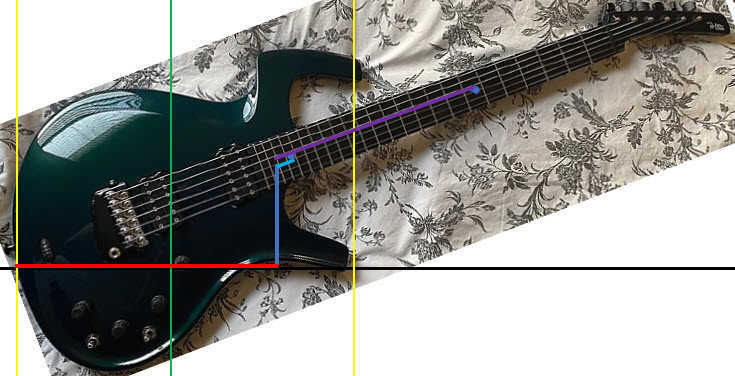
|
|

|
|
|
|
The Parker Fly was designed by Ken Parker and Larry Fishman, and
produced by Parker Guitars first in 1993 until it was last
produced in 2016. Similar to the Klein described above, the Fly uses composite materials for light weight
ergonomics and sonic resonance.
A 26 year production run isn't bad and the list of performers that have used this guitar is
impressive. For those of us who read guitar discussion forums,
the Parker Fly comes up as the "most" ergonomic
guitar about as often as the Klein guitars do whenever a
thread on ergonomics gets going. I tabulate and discuss the
ergonomic statistics for this guitar below, but suffice to say
that if ergonomics were the leading factor in most players' buying
decision, the Fly would still be in production. Based on the
ergomic statistics, the Fly is as good or better than a
T-style guitar, but still within the realm of a familiar guitar
shape and feel.
In addition to having better ergonomic
statistics than a T-style guitar, the Fly also has makes a
much broader sonic palette available to the player. I'm sure
it could quack like a Tele if you want it to, but there's a
lot more to the Fly's sonic range than that. Better ergonomics
and better sonic palette you say? Then certainly the Fly
should be selling like hotcakes and the T-style guitars should
be collecting dust in the music stores, right? Nope.
|
Seated tilt range - 0 to 31 degrees
Rest point -
0.9 inches behind the 21st fret
Rest point rise - 5.3
inches
Left hand reach - 10.6 inches |
Leg spread - 13.9 inches
Strap button midpoint - Bridge pickup
Strap
button forward location - 15th fret
Total weight - 4.5 pounds |
The Fly's ergonomic statistics while
playing in the folk position are almost identical to T-style
guitars, so the guitar would feel familiar to most electric
guitar players. The Fly has a 50% greater range of tilt
angles, and this range is a superset of the range available
with a T-style guitar. This means the player could hold it like a
Tele, but also use greater tilt angles if desired. The
Fly is also has a much thinner body and almost no neck heel
relative to a Tele. This would make the Fly feel more
"transparent" to the player, which most players
would almost certainly prefer.
The Fly's ergonomic guitar design statistics standing are about the
same as the Strat-style guitars, with the exception that the
total weight of the Fly is three full pounds less. Add the
Fly's thin body and sculpted neck heel to the equation and the Fly has what
look to be excellent standing ergonomics. No
wonder the list of famous performers that have played the Fly
on stage is so long.
|
|
|
|
More electric guitar ergonomic analysis to come...
|
|
|
|
I'm currently working on statistics and analyses for Steen,
Forshage, Claas, Strandberg and Abassi electic guitars; and will add
these as I finish them for each guitar.
|
|
|
|
|
|
copyright notice
|
|
|
|



